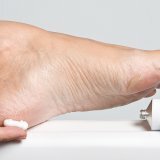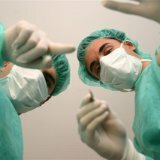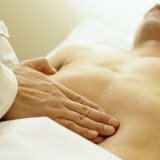Varieties of hernia and their treatment
 Hernia is an unpleasant pathology that every person can have. Hernia can be different: intervertebral, inguinal and the like. In this article, we will tell you in more detail about each type of hernia, and also tell you how to prevent the appearance of such a pathology.
Hernia is an unpleasant pathology that every person can have. Hernia can be different: intervertebral, inguinal and the like. In this article, we will tell you in more detail about each type of hernia, and also tell you how to prevent the appearance of such a pathology.
Most often, the hernia occurs at a place where there is a constant pressure on the outer shell of the organs. When a hernia arises, "hernial gates" through which the organs begin to bulge outward. In addition to physical discomfort, hernia also causes psychological discomfort, because it looks completely aesthetic.
Abdominal hernia
When the abdominal hernia appears on the skin of a tubercle, which easily refreshes when you press it with your finger. However, the hernia disappears only for a short period of time, after which a bump appears again. In addition, the hernia is accompanied by the appearance of pain, which sometimes is very strong. In such cases, the patient can only benefit from surgery. Therefore, if you have a hernia, you should immediately consult a doctor and take care of her treatment.
The appearance of a hernia indicates that some organs have shifted from their seats. That is why the doctor appoints a full examination of the patient to exclude the appearance of new hernias. Some patients, noticing in their own pathology, do nothing, as the hernia easily gets in place and does not cause discomfort. But this is very dangerous. The thing is that the longer the hernia exists, the wider the hernia gates become, which means that the organs are shifting more and more from their places. As a result, the normal functioning of the organs is disrupted and the intestine can enter the hernial sac. This forms a loop. And after all, the intestine is constantly digested food, and the loop will slow down and disrupt the process of peristalsis. Because of this, food can begin to rot in the intestines, and this can lead to peritonitis and blood infection.
Unfortunately, a stomach hernia is treated only surgically. The doctor makes a small incision, the hernial ring is sutured, and the organs remain in their rightful places. To reduce the risk of developing this type of hernia, it is necessary to train the abdominal muscles. However, you should avoid too much physical activity.
Umbilical hernia
This type of hernia is common. Most often it occurs in young children. It provokes the development of hernia that the baby often screams, straining at the same tummy. As a result, weak tendons and ligaments of the umbilical ring do not withstand muscle tension and a hernia is formed. Fortunately, this kind of hernia can eventually disappear on its own, when the umbilical ring is fully formed. But doctors also face such cases, when the formed umbilical hernia begins to appear in adulthood.
In infants, the treatment of such a pathology is conservative. The doctor applies a wide band-aid to the baby, which prevents stretching of the tendons and muscles. As a result, the hernia passes by itself. However, do not attempt to treat such a hernia yourself in infants. In order to properly paste a patch, you need to know the anatomy, otherwise you can hurt the health of crumbs. In adulthood, the umbilical hernia is treated surgically. There are several methods of treatment:
- Autoplasty. With this method, the integrity of the abdominal wall is restored at the expense of its own tissues. At the site of the hernia, the membrane thickens to prevent the recurrence of pathology.
- Endoscopic method is a low-traumatic surgical intervention, in which an umbilical is placed on the umbilical ring - an implant that prevents the protrusion of the hernia.
To prevent the development of this pathology is very simple. To do this, do not let the baby cry for a long time. Of course, if the crumb will scream for 15-20 minutes, it's not scary. However, if he screams for an hour and a half all the time, then we need to take action.
Inguinal hernia
Inguinal hernia is a congenital defect that occurs as a result of an indentation of the peritoneal site that covered the testicle. With frequent constipation, severe exertion or with a sharp increase in body weight, the intestine gets into the already existing hernial sac. In such cases, the hernia should be treated as soon as possible.
Inguinal hernia is treated only surgically. Most often, surgeons use an endoscopic method of treatment in which a defective site of the abdominal wall is sutured or placed on it with a special mesh that prevents protrusion of the hernia.
Herniated spine
Hernia of the spine arises because the membrane of the disc is thinned, and the contents of the disc begin to bulge outward into the cavity of the spinal column. The hernia presses on the nerve roots, which provokes the appearance of acute pain. First, the pain occurs only when a person is engaged in physical activity. However, if the hernia is not treated, then it will appear with any movement.
Hernial protrusion of the disc clamps the nerve roots, as a result of this, the conductivity of the nerve impulse is disrupted. Therefore, a person with a vertebral hernia will always get cold hands, the skin will change, and the sensitivity of the limbs may also be disturbed.
Treatment of vertebral hernia is not easy. It is necessary to find an experienced specialist who could remove this pathology without damaging the spine. A slight relief to the patient brings a lying position with his legs raised up. In this situation, the strained muscles relax and the innervation improves. Most likely, the doctor will recommend the patient to spend several months in bed. Anesthetics are also prescribed. In some cases this is very effective.
If the above described method does not help, the doctor can prescribe stretching the spine. With this procedure, the spinal disc becomes in place. However, this method requires a lot of time. After all, the patient must adhere to bed rest for a long time to recover. Unfortunately, this method is not always effective either.
If both methods described did not help the patient and his condition did not improve, then doctors prescribe surgical treatment. After the operation to remove the disk of the spine, the disks between which the disk was removed grow together. This affects the mobility of the body in the future, but the pain disappears, and a person can lead a full-fledged lifestyle. After the operation to remove the spinal disc, the recovery period takes about four months.
To prevent intervertebral hernia, try to keep your back straight, do not slouch, and do not sit in the same position for a long time. In order for the muscles to relax faster and keep the vertebrae and intervertebral discs in their natural position, change the posture. Also after the treatment, special exercises are needed to strengthen the muscles of the back. It is because of the weakening of the muscles and there is a hernia.
It is also very useful to perform special exercises for the back in the gym. There certainly will be special simulators that are designed to strengthen the spinal muscles. It is not necessary to take high loads, enough medium. You can also do at home with dumbbells. On the Internet, you can find a lot of video lessons.



